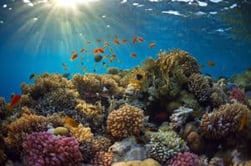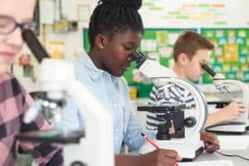Electrical Forces Inquiry Lab
Middle School Inquiry Lab on Electrical Forces
In this lab students will build a charge detector. They will use it to explore the electrical force interactions between two objects. They will determine that the energy and distance between different objects influences the electric force.
Each inquiry lab will contain an essential question that will drive the lesson and make students think. For this lesson, the essential question is:
- What factors influence electric forces between two objects?
BACKGROUND INFORMATION AND MATERIALS LIST:
Students will begin the lab by reading the essential question and background information. This can be done individually, as lab groups, or as a whole class. If you consider lab groups, you also might include some type of whole class formative checks before digging into the lab.

Materials List:
- a square of aluminum foil
- a wide mouth jar
- thin cardboard (cereal box)
- silver foil from a candy bar
- balloon
- scissors
- paper clip
- tape
- pairs of items such as wool or nylon
PROCEDURE:
For this lab, students will be testing the electrical charge between objects. Students will construct an electroscope and will use it to test the conductivity of a variety of materials. First using a balloon, students will charge the item and test whether electrical forces are present using the electroscope. Students will continue using this material three more times before moving on to a new material. Students will repeat all steps for each of the materials tested.
CHECK FOR UNDERSTANDING:
At this point in the lab, students will be checked for understanding by answering questions about their findings. Here are a few that come with the lab:
- What happened when you doubled the charging time?
- What do you think would happen if you double it again?
- Of the materials you tested, which are conductors? Which are insulators?
CONCLUSION
Students will go back to the essential question and write a CER (Claim, Evidence, Reasoning) to conclude the lab. Once completed, students will reflect back on their learning by answering the following questions:
- What is a real world application of this concept? For instance, when would it be important to know how to discharge excess electric charge?
MODIFIED AND INDEPENDENT INQUIRY VERSIONS
All of the Kesler Science inquiry labs come with three different modification levels. Each lab is differentiated using the icons below.
STANDARDS ALIGNMENT
NGSS: MS PS2-5 – Conduct an investigation and evaluate the experimental design to provide evidence that fields exist between objects exerting forces on each other even though the objects are not in contact.

Download Over $100 in FREE Resources
For Middle School Science
Simply create a login below and gain immediate access to a selection of our Kesler Science product line worth $100 - for FREE. There's a full version of every product type! You'll also join tens of thousands of middle school science teachers who receive timely tips and strategies straight to their inbox.





